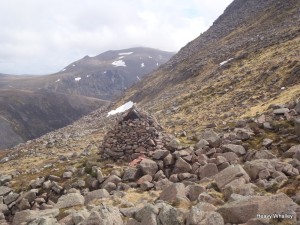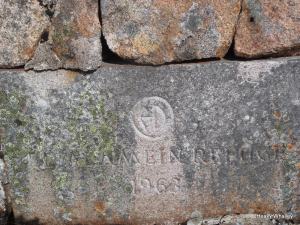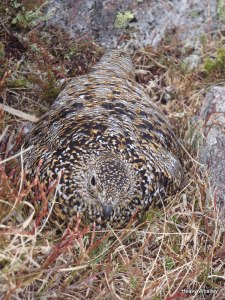The El Alamein’s bothy in the Cairngorms location was accidental – intended to be sited at the plateau’s edge just above the gently sloping grassy Coire na Spreidhe (Coire of the Cattle), a mistake in the map reference saw it constructed some distance beneath this coire, on the steep and boulder-strewn slopes of Strath Nethy. This is a lovely part of the Cairngorms with great views of Strath Nethy and Loch Avon. It is a place to sit and enjoy the views and peace away from the industrial Ski area. It is amazing what wild life you see so close to this busy area but in summer it is usually peaceful and enjoyable.
A small line of tiny (now largely collapsed) never found them cairns lead down towards it, but even on a good day these would be difficult to discern from the other piles of rock which are abundant in this area. Other incidents influenced matters too. In November 1972, there was the so-called Cairngorm Tragedy when seven children in a school party perished in the winter weather. The subsequent Fatal Accident Inquiry concluded that the existence of Curran Bothy caused the school party to head for it to spend the night, and hence if it had not been there they would not have headed for it and not gone on and perished. There are other arguments against bothies on the highly vulnerable plateau.
The plateau bothies, the Curran Bothy and the St Valery were demolished and the El Alamein left to its own devices. Jean’s Hut and the Sinclair Hut have gone,for various reasons. The Fords of Avon bothy on land owned by the RSPB has recently been rebuilt, but not for overnight accommodation. Basically it is an emergency shelter for those marooned while crossing the Lairig and Loaigh. It has been credited with saving several lives over the years. Whatever your views these places were and are part of the history of this place and make a good navigation exercise locating where they were and how they effected this wild area,
A stone is emebedded in the wall of the bothy it reads El Alamein Refuge 1963. It has the badge of the 51 st Highland Division that was thought they built the shelter a similar plaque lies at the former site of the St Valery Refuge. The military trained heavily in this area of the Cairngorms during the war, using the harsh environment as a test for the troops.
This is from Ray Sefton the guru of the Cairngorms – However, I have to make a minor correction to the history of the bothies. They were not built by the 51st Highland Division, but in memory of the Division. They were built by the Artificer Apprentices from HMS Caledonia, Rosyth, led by CSM Jim Curran of the Royal Marines. Jim married a local girl and lived in Aviemore for many years. The metal work for the El Alamein, Curran, St Valery and Fords of Avon were made in the workshops at Rosyth and carried to the sites as part of adventure training exercises and the walls were then built. I think the reason the El Alemain survived is that it was located in Inverness-shire, whereas the others were in Moray or Banffshire. Thanks Ray Sefton!
The plaque for the St Valery Refuge is worth trying to find a what a location it is in and makes an interesting search for a group. You wonder how many stories of nights in these wee bothies in the past. I spent a couple of nights in the 70’s as it was a great area for a night Exercise and a part that few of the Team knew. It would be hard to find in the days before GPS and many times it was very hard work to locate. It is as I said a great place to spot wild life and the many ptarmigan that live in this area are hard to spot especially during the nesting season. Be aware where you are walking as their camouflage is incredible, it is easy to stand on a nesting bird such is their dedication to their young. Please be as careful as you can not to disturb the nesting birds.
This is not a barren wasteland but a place of great beauty and solitude. enjoy it. I hope to get out this weekend at long last!
From George Mc Ewan – The background to the HD symbol is St Valery was where the original 51st Highland Division was captured by the Germans whilst serving as a rearguard for the British Army pulling out of Dunkirk in 1940. It was reformed and the reborn division’s baptism of fire was at El Alamein in 1942. The Gordon Highlanders who made up one of the main infantry components of the division recruited from around this part of the Highlands. I think that’s the link. My Grandfather served with the 51st during this period and from his diary and the histoRy of the 51st they were mostly based up in the NE and around to Inverness – I’ve not read that they actually trained in the hills. The 51st’s sister division – 52nd Highland Division did train in the Cairngorms – they were being trained up as a mountain warfare division, complete with pack howitzers and mule trains ran by Sikh muleteers. Their first action in 1944 was – part of the division shipped off to the jungles of Burma, the other part took part in the fighting in the flooded coastal areas of Holland! Both a far cry from the Cairngorms.
Thanks for the information.





Hi Heavy
The background to the HD symbol is St Valery was where the original 51st Highland Division was captured by the Germans whilst serving as a rearguard for the British Army pulling out of Dunkirk in 1940. It was reformed and the reborn division’s baptism of fire was at El Alamein in 1942. The Gordon Highlanders who made up one of the main infantry components of the division recruited from around this part of the Highlands. I think that’s the link. My Grandfather served with the 51st during this period and from his diary and the histroy of the 51st they were mostly based up in the NE and around to Inverness – I’ve not read that they actually trained in the hills. The 51st’s sister division – 52nd Highland Division did train in the Cairngorms – they were being trained up as a mountain warfare division, complete with pack howitzers and mule trains ran by Sikh muleteers. Their first action in 1944 was – part of the division shipped off to the jungles of Burma, the other part took part in the fighting in the flooded coastal areas of Holland! Both a far cry from the Cairngorms.
LikeLike
Thanks George will add it too the blog – Ray Sefton also gave us some more info – thanks!
LikeLike
Nice article on the Bothies. However, I have to make a minor correction to the history of the bothies. They were not built by the 51st Highland Division, but in memory of the Division. They were built by the Artificer Apprentices from HMS Caledonia, Rosyth, led by CSM Jim Curran of the Royal Marines. Jim married a local girl and lived in Aviemore for many years. The metal work for the El Alamein, Curran, St Valery and Fords of Avon were made in the workshops at Rosyth and carried to the sites as part of adventure training exercises and the walls were then built. I think the reason the El Alemain survived is that it was located in Inverness-shire, whereas the others were in Moray or Banffshire.
LikeLike
Thanks Ray do you a photo of St Valerys -I remember something in the past about one?
LikeLike
My husband, Sooty Sutcliffe and his class, WM15 of weapons mechanician apprentices built the Curran Bothy in 1967? In the Cairngorms. Not Artificers apprentices . Brenda Sutcliffe
LikeLiked by 1 person
Thank you for that will pass that on.
LikeLike
I remember the late Blyth Wright telling me that he spent the night in St Valery’s with some RAF guys. It was so wild a night, you did not dare go outside otherwise it would have taken you over the cliffs. Did the refuge not have a pole with a bell on it or something like that?
LikeLike
Thanks for that – that was on a call – out I am sure? I never heard about the Pole with the Bell though – will ask about!
LikeLike
The St Valery did have a pole with a bell . There was an orange marker on the pole and from the top of Cairngorm the alignment of this made the unknowing think it was a climber with an orange jacket on the Shelter Stone Crag.
I think the El Alemain refuge should also have been removed. It is dilapadated with big spaces in the roof…and so now is nothing more than litter. The Marines should organise this.
LikeLike
THANKS FOR THAT
LikeLike
I did not know that very interesting will speak to some friends on this?
LikeLike
Maybe the co-ordinates were correct, just the continent was off.
LikeLike
Heavy were your photos recent or is the following the true condition of the refuge? Rgds Davie
http://www.geograph.org.uk/photo/544410
LikeLike
Yes mate – last year!
LikeLike
Hi Heavy, never having been to the bothy I was intrigued by your article and the comments. I punched your GR into Memory Map which gave the position somewhere in deepest Argyll. The grid square should be NJ not NN . I look forward to trying to locate it.
LikeLiked by 1 person
Sorry will change it
LikeLike
Heavy – Thanks for your interesting post. Four of us visited the refuge on Saturday 23 January 2016. It was a fine day, although very windy indeed on the way up from the ski car park, it was less windy by the refuge. The condition of the refuge appear similar to the photo you show. My location for the refuge is NJ 01579 05394, elevation 968 m. This is the average of three very similar readings with my Garmin GPSmap 62S. I was inside the refuge, but had a full GPS signal. The location you quote, NJ 01651 05358, is about 70 m away.
LikeLike
Thanks for that we do not want to make it too easy to find !
LikeLike
Heavy, interesting and helpful blog about the old refuge. I visited last Wednesday for the first time, seems to be in reasonable nick although snow does get in through the North Gable.
We approached from the North (spot height 1028m) and picked up the hut from quite a distance away (admittedly in reasonably good conditions). Interestingly, we left by walking up the boulder field towards the plateau and looking back to the hut from a few hundred metres away it was almost impossible to spot as it blends into the background of the boulder field and rocks on the other side of Strath Nethy. My phone gps using Viewranger gave a GR of NJ01581 05395 at 986m. Make of that what you will 🙂
To complete the story, the next day I walked into the Garbh Corrie refuge which seemed a bit more weather proof than Alamein despite the door having fallen off, It certainly provided some welcome respite from the wind.
Cheers
Graham Gedge
LikeLiked by 1 person
Thanks it is hard to see from a distance in heavy snow I have a great photo that shows that on the blog.
LikeLike
Fascinating reading about the history of these refuges. During several visits last summer / autumn , sorry to be vague but don’t have exact dates I found the refuge had been repaired . Someone had carried in materials and patched up the roof on the east facing side and the door has been repaired now and back to being closed. I have asked lots of people including knowledgeable staff up Cairngorm but nobody knows who did this.Can you shed any light on this one ? I was just skiing there yesterday and checked it out again.
My sentiments are it should remain as it is a memorial to those men who lost their lives at El Alamein . My grandfather was one of those men from the Black Watch . It is a special place of outstanding beauty and a great place to appreciate the sheer beauty of the Cairngorms . I have been there a few times with my wee lassie Anna and we have proudly remembered Sergeant John Cameron .
Cheers
Colin Hutt
LikeLiked by 1 person
Thanks Colin – Maybe someone will come back to us I will put this on the blog.
LikeLike
I found reference to repairs when researching my visit I commented on earlier. I was sure it was on UKC forums but couldn’t find anything. Then I found the post by Jim Fraser on your “More on El Alamein….” (https://heavywhalley.wordpress.com/2016/08/20/more-on-el-alamein-refuge-in-the-cairngorms-bothies-threatened-by-commercial-groups/). I wonder if those are the repairs that Colin talks about? The description by Jim seems to match what I found during my visit. Or maybe someone else has picked up the baton.
LikeLiked by 1 person
Thanks very much for the info Graham mystery solved . Thanks also to Jim for carrying out these repairs and well done .
LikeLike
Great a bit more info!
Sent from my iPhone
>
LikeLike
The “Feith Buidhe” disaster was on the weekend of 20th/21st November 1971. Five 15 yeear olds from Ainslie Park school in Edinburgh and an 18 year old trainee instructor died. (https://www.edinburghlive.co.uk/news/edinburgh-news/nearly-50-years-ago-five-15726762). They had been on a navigation exercise on the Cairngorm plateau and their fall back plan had been to go to the Curran bothy if conditions deteriorated. A blizzard blew up and they were unable to locate the bothy in the white out. They died of hypothermia following a decision to bivouac near the, unseen, Feidh Buidh burn. I was halfway throiugh my Mountain Leadership training course at Moray House College in Edinburgh at the time and all of the course participants were greatly affected by the tragedy. Following the disaster, Edinburgh Education Committee tightened up protocols for school trips. Detailed plans had to be submitted to the senior outdoor education advisor for vetting. Anyone proposing to take a school group above 2000′ (I think that was the cut off) had to be in posession of a Scottish Mountain Learership qualification.
LikeLiked by 1 person
Yes I have written about it a lot and Few know that the RAF MRT from Kinloss were involved in the Rescue.
LikeLike